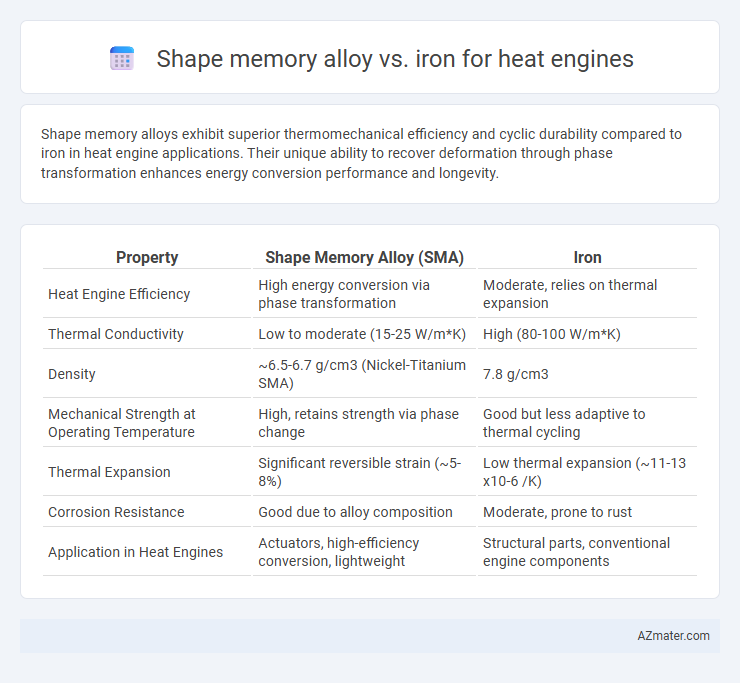Shape memory alloys exhibit superior thermomechanical efficiency and cyclic durability compared to iron in heat engine applications. Their unique ability to recover deformation through phase transformation enhances energy conversion performance and longevity.
Table of Comparison
| Property | Shape Memory Alloy (SMA) | Iron |
|---|---|---|
| Heat Engine Efficiency | High energy conversion via phase transformation | Moderate, relies on thermal expansion |
| Thermal Conductivity | Low to moderate (15-25 W/m*K) | High (80-100 W/m*K) |
| Density | ~6.5-6.7 g/cm3 (Nickel-Titanium SMA) | 7.8 g/cm3 |
| Mechanical Strength at Operating Temperature | High, retains strength via phase change | Good but less adaptive to thermal cycling |
| Thermal Expansion | Significant reversible strain (~5-8%) | Low thermal expansion (~11-13 x10-6 /K) |
| Corrosion Resistance | Good due to alloy composition | Moderate, prone to rust |
| Application in Heat Engines | Actuators, high-efficiency conversion, lightweight | Structural parts, conventional engine components |
Introduction to Heat Engines
Shape memory alloys (SMAs) offer unique thermomechanical properties, allowing them to recover deformation and produce work via phase transformation, making them promising materials for heat engines. Iron, a traditional metal used in heat engines, primarily relies on thermal expansion and mechanical strength but lacks the reversible strain capabilities of SMAs. Heat engines convert thermal energy into mechanical work, and the distinctive behavior of SMAs enables more efficient energy conversion through thermally induced actuation compared to conventional iron-based components.
Overview of Shape Memory Alloys (SMA)
Shape Memory Alloys (SMAs) exhibit unique thermomechanical properties, enabling them to undergo reversible phase transformations that convert thermal energy into mechanical work efficiently. Unlike iron, which primarily relies on conventional thermal expansion, SMAs offer higher energy density and precise actuation due to their superelasticity and shape memory effects. These characteristics make SMAs ideal for heat engine applications where compact size, durability, and responsive motion are critical factors.
Properties of Iron in Heat Engine Applications
Iron exhibits high thermal conductivity and excellent mechanical strength, making it suitable for heat engine components exposed to high temperatures and stress. Its ability to withstand thermal cycling without significant deformation ensures durability and consistent performance in engine parts like pistons and cylinders. Additionally, iron's cost-effectiveness and wide availability contribute to its preference in large-scale heat engine manufacturing.
Thermal Efficiency: SMA vs Iron
Shape memory alloys (SMAs) exhibit significantly higher thermal efficiency in heat engines compared to iron due to their ability to undergo reversible phase transformations, which convert thermal energy into mechanical work with minimal losses. SMAs can achieve thermal efficiencies up to 20%, outperforming iron that typically shows lower efficiency because of its higher thermal conductivity and energy dissipation through irreversible deformation. The enhanced energy recovery and reduced hysteresis in SMAs make them superior materials for thermomechanical energy conversion in heat engine applications.
Mechanical Strength and Durability Comparison
Shape memory alloys exhibit superior mechanical strength and durability compared to iron in heat engine applications due to their ability to undergo reversible phase transformations without significant degradation. These materials maintain structural integrity under cyclic thermal and mechanical loads, whereas iron tends to suffer from fatigue and corrosion over time. The enhanced fatigue resistance and corrosion stability of shape memory alloys result in longer operational lifespans and reduced maintenance costs in heat engine components.
Response to Temperature Changes
Shape memory alloys exhibit a unique ability to undergo reversible phase transformations in response to temperature changes, enabling significant shape recovery and mechanical work output, making them highly efficient for heat engine applications. In contrast, iron primarily experiences linear thermal expansion and lacks the reversible martensitic transformation, resulting in limited mechanical response and lower efficiency in converting thermal energy to mechanical work. The distinct thermo-mechanical properties of shape memory alloys, including high strain recovery and rapid response times, provide superior performance compared to iron in heat engines exploiting temperature-induced phase changes.
Energy Conversion Mechanisms
Shape memory alloys (SMAs) convert thermal energy into mechanical work through phase transformations between martensite and austenite, enabling efficient cyclic actuation in heat engines. In contrast, iron primarily relies on magnetic hysteresis and thermal expansion, offering less direct and efficient energy conversion mechanisms. The superior fatigue resistance and reversible deformation characteristics of SMAs enhance their performance and energy conversion efficiency in thermal engine applications compared to iron.
Practical Applications and Use Cases
Shape memory alloys (SMAs) offer superior mechanical energy recovery and high strain sensitivity, making them ideal for efficient heat engine actuators in temperature-variable environments like aerospace and biomedical devices. In contrast, iron's widespread availability, magnetic properties, and structural strength suit traditional heat engine components such as pistons and crankshafts in automotive and heavy machinery applications. SMAs enable compact, low-maintenance thermal actuators, while iron-based engines benefit from cost-effective manufacturing and durability under high thermal stress conditions.
Cost and Material Availability
Shape memory alloys (SMAs), while offering superior efficiency in heat engine applications due to their ability to convert thermal energy into mechanical work with minimal losses, are significantly more expensive and less abundant than iron. Iron is widely available, cost-effective, and has a well-established supply chain, making it a more practical choice for large-scale heat engine manufacturing despite its lower efficiency. The high material and processing costs of SMAs limit their use primarily to specialized, high-performance applications where cost is less critical.
Future Prospects in Heat Engine Technology
Shape memory alloys (SMAs) offer significant potential in heat engine technology due to their ability to undergo reversible phase transformations, enabling efficient conversion of thermal energy into mechanical work with minimal energy loss. Unlike conventional iron-based materials, SMAs can provide higher energy density and improved fatigue resistance, which are critical for the development of compact and durable heat engines. Future advancements in SMA composition and manufacturing techniques promise enhanced performance, paving the way for innovative applications in renewable energy systems and smart actuators within heat engines.

Infographic: Shape memory alloy vs Iron for Heat engine
 azmater.com
azmater.com